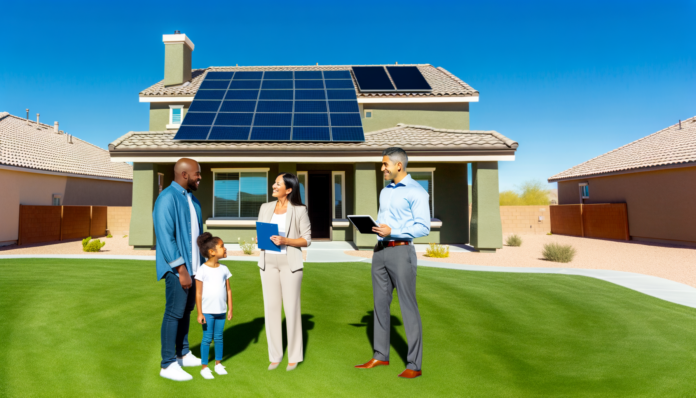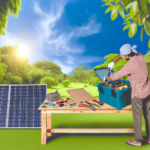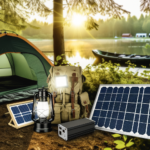Introduction to Solar Gear Financing
The Growing Popularity of Solar Gear
In recent years, solar energy has seen a significant surge in popularity. This growth is driven by a combination of environmental awareness, technological advancements, and economic incentives. Solar gear, including solar panels, inverters, and battery storage systems, has become more efficient and affordable, making it an attractive option for homeowners and businesses alike. According to industry reports, U.S. solar jobs have increased by 167% over the past decade, outpacing the overall job growth rate in the U.S. economy. This trend is expected to continue as more people recognize the benefits of solar energy, such as reducing electricity bills, increasing property value, and contributing to a cleaner environment.
Why Financing is Important
Despite the long-term savings and environmental benefits, the initial costs of purchasing and installing solar gear can be prohibitive for many consumers. This is where financing comes into play. Financing options can significantly lower the upfront costs, making solar energy accessible to a broader audience. Various financing methods, such as loans, leases, and power purchase agreements (PPAs), offer flexibility to suit different financial situations. For instance, solar loans can spread the cost over several years, often with monthly payments lower than traditional energy bills. Additionally, government incentives and rebates, like the Solar Investment Tax Credit (ITC), can further reduce the financial burden. Understanding these financing options is crucial for anyone considering a switch to solar energy.
Overview of the Article
This article aims to provide a comprehensive guide to solar gear financing, helping you navigate the various options available to make solar energy more affordable. We will start by breaking down the costs associated with solar gear, including initial purchase, installation, and maintenance expenses, as well as the long-term savings and return on investment (ROI). Next, we will explore different financing options, such as personal savings, loans, leasing, and government incentives. We will also discuss how to evaluate the best financing strategy for your specific situation, including assessing your financial health, comparing options, and calculating potential savings. Additionally, we will offer tips for securing financing, such as improving your credit score and understanding loan agreements. To provide real-world context, we will include case studies and examples of successful and unsuccessful financing stories. Finally, we will conclude with a recap of key points and a look at emerging trends in solar gear financing.
By the end of this article, you will have a thorough understanding of the strategies and options available to afford quality solar products, empowering you to make an informed decision that aligns with your financial goals and sustainability aspirations.
Understanding the Costs of Solar Gear
Initial Purchase Costs
The initial purchase costs of solar gear can be substantial, but they are a critical investment in sustainable energy. The primary components include solar panels, inverters, mounting systems, and batteries if you opt for energy storage. The cost of solar panels varies based on their type and efficiency. Monocrystalline panels, known for their high efficiency, range from $1 to $1.50 per watt, while polycrystalline panels are more affordable at $0.70 to $1 per watt. Thin-film panels, though less efficient, cost between $1 and $1.50 per watt.
In addition to the panels, inverters are essential for converting the direct current (DC) generated by the panels into alternating current (AC) used by most home appliances. The cost of inverters can range from $1,000 to $3,000 depending on the system size and type. Mounting systems, which secure the panels to your roof or ground, add another $500 to $3,000 to the initial costs. If you choose to include a battery storage system, expect to pay an additional $5,000 to $7,000.
Installation and Maintenance Costs
Installation costs are another significant factor to consider. These costs can vary widely based on the complexity of the installation, the type of roof, and local labor rates. On average, installation costs range from $3,000 to $10,000. This includes labor, permits, and inspection fees. It’s important to note that installation costs can be higher in areas with stringent building codes or where specialized equipment is required.
Maintenance costs for solar gear are relatively low compared to other home improvement projects. Solar panels are designed to be durable and require minimal upkeep. However, periodic cleaning and inspections are recommended to ensure optimal performance. The average annual maintenance cost is around $150 to $300. Inverters typically need replacement every 10 to 15 years, adding a potential future cost of $1,000 to $3,000.
Long-term Savings and ROI
While the initial and installation costs can be high, the long-term savings and return on investment (ROI) make solar gear a financially sound decision. Solar panels can significantly reduce or even eliminate your electricity bills. The average monthly electricity bill in the U.S. is around $120, which translates to $1,440 annually. Over a 25-year lifespan, this amounts to $36,000 in savings.
Moreover, solar panels increase property value. Homes with solar installations sell for approximately 4.1% more than comparable homes without solar. This added value can offset the initial investment, making solar gear an attractive option for homeowners.
Government incentives and rebates further enhance the ROI. The federal Solar Investment Tax Credit (ITC) offers a 26% tax credit for systems installed in 2020-2022 and 22% for systems installed in 2023. Some states and local governments also offer additional incentives, such as rebates, property tax exemptions, and net metering programs, which allow you to sell excess energy back to the grid.
In conclusion, while the upfront costs of purchasing and installing solar gear can be significant, the long-term savings, increased property value, and available incentives make it a worthwhile investment. By understanding these costs and potential savings, you can make an informed decision about transitioning to solar energy.
Financing Options for Solar Gear
Personal Savings and Budgeting
One of the most straightforward ways to finance solar gear is through personal savings. By setting aside a portion of your income over time, you can accumulate the necessary funds to purchase and install solar panels without incurring debt. This method requires disciplined budgeting and a clear savings goal. The primary advantage is that you avoid interest payments and loan fees, making the overall cost lower. However, the significant upfront cost, which can average around $31,558 for a solar panel system in the U.S., might be a barrier for many.
Loans and Credit Options
For those who cannot afford the upfront costs, loans and credit options provide a viable alternative. Several types of loans can be used to finance solar gear:
- Personal Loans: These are unsecured loans with fixed interest rates and monthly payments. They are relatively easy to obtain if you have good credit, and the funds can be available quickly.
- Home Equity Loans and HELOCs: These loans use your home as collateral, often offering lower interest rates. Home equity loans provide a lump sum, while Home Equity Lines of Credit (HELOCs) offer a revolving credit line.
- FHA and Fannie Mae Loans: These government-backed loans allow you to finance solar installations as part of your mortgage, making them an excellent option for new homeowners.
Each loan type has its pros and cons, such as varying interest rates and eligibility requirements, so it’s essential to compare options to find the best fit for your financial situation.
Leasing vs. Buying
Leasing solar panels or entering into a Power Purchase Agreement (PPA) can be an attractive option for those who want to avoid the high upfront costs.
- Solar Lease: You pay a fixed monthly fee to use the solar system, which is owned and maintained by the leasing company. This option often requires little to no money down.
- Power Purchase Agreement (PPA): You agree to purchase the electricity generated by the solar system at a predetermined rate, usually lower than your current utility rate. The solar provider owns and maintains the system.
While leasing and PPAs can reduce your energy bills and eliminate maintenance responsibilities, they do not qualify for tax incentives, and the long-term savings are generally lower compared to purchasing a system outright.
Government Incentives and Rebates
Government incentives and rebates can significantly reduce the cost of solar gear. The most notable is the federal Investment Tax Credit (ITC), which offers a 30% tax credit on the cost of solar installations through 2032. This credit decreases to 26% in 2033 and 22% in 2034 before phasing out.
Many states also offer additional incentives, such as:
- State Tax Credits: Some states provide tax credits that can be combined with the federal ITC.
- Net Metering: This allows you to sell excess electricity generated by your solar panels back to the grid, reducing your overall energy costs.
- Sales and Property Tax Exemptions: Some states exempt solar installations from sales tax and property tax assessments, further lowering the cost.
Utilizing these incentives can make solar gear more affordable and improve the return on investment, making it a more attractive option for homeowners and businesses alike.
Evaluating the Best Financing Strategy for You
Assessing Your Financial Situation
Before diving into the various financing options available for solar gear, it’s crucial to assess your current financial situation. This involves understanding your income, expenses, and overall financial health. Start by creating a detailed budget that includes all your monthly income sources and expenses. This will help you determine how much you can afford to allocate towards solar gear without straining your finances.
Consider your credit score as well, as it plays a significant role in securing loans and favorable interest rates. A higher credit score can open doors to better financing options, including lower interest rates and more flexible terms. If your credit score needs improvement, take steps to enhance it before applying for financing.
Comparing Different Financing Options
Once you have a clear understanding of your financial situation, the next step is to compare the different financing options available for solar gear. Here are some common options:
- Personal Savings and Budgeting: Using personal savings to purchase solar gear outright can save you from paying interest and other financing fees. However, this option requires having a substantial amount of money set aside.
- Loans and Credit Options: Solar loans can significantly reduce the upfront costs of solar gear. These loans function similarly to home improvement loans, and some jurisdictions offer subsidized solar energy loans with below-market interest rates. Additionally, new homeowners can include solar financing in their mortgage through programs offered by the Federal Housing Administration and Fannie Mae.
- Leasing vs. Buying: Leasing solar gear or entering into a Power Purchase Agreement (PPA) allows you to host solar systems owned by solar companies. This option often requires little to no upfront cost and provides lower electricity bills without monthly loan payments. However, you won’t be eligible for tax benefits since you don’t own the system.
- Government Incentives and Rebates: Various government incentives, such as the Solar Investment Tax Credit (ITC), can significantly reduce the cost of solar gear. The ITC offers a 26% tax credit for systems installed in 2020-2022 and 22% for systems installed in 2023. Additionally, state and local rebates can further lower the overall cost.
Calculating Potential Savings
To determine the best financing strategy, it’s essential to calculate the potential savings from each option. Start by estimating the total cost of the solar gear, including purchase, installation, and maintenance. Then, factor in any available incentives, rebates, and tax credits to reduce the overall cost.
Next, compare the monthly payments for loans or leases against your current electricity bills. In many cases, the monthly loan payments for solar gear are lower than typical energy bills, resulting in immediate savings. Additionally, consider the long-term savings from reduced energy costs and the potential increase in property value.
Finally, calculate the return on investment (ROI) by comparing the total savings over the system’s lifespan to the initial investment. This will help you determine which financing option offers the best value for your specific situation.
By thoroughly assessing your financial situation, comparing different financing options, and calculating potential savings, you can make an informed decision on the best financing strategy for your solar gear investment.
Tips for Securing Financing
Improving Your Credit Score
A strong credit score is crucial when seeking financing for solar gear. Lenders use your credit score to assess your creditworthiness, which influences the interest rates and terms you can secure. Here are some strategies to improve your credit score:
- Pay Bills on Time: Consistently paying your bills on time is one of the most effective ways to boost your credit score.
- Reduce Debt: Lowering your overall debt, especially high-interest credit card debt, can positively impact your credit score.
- Check Credit Reports: Regularly review your credit reports for errors and dispute any inaccuracies with the credit bureaus.
- Limit New Credit Inquiries: Avoid applying for multiple new credit accounts in a short period, as this can lower your score.
Improving your credit score can take time, but the benefits of securing better financing terms make it a worthwhile effort.
Negotiating Terms and Rates
Once you have a good credit score, the next step is to negotiate the best possible terms and rates for your solar gear financing. Here are some tips to help you in the negotiation process:
- Shop Around: Compare offers from multiple lenders to find the most competitive rates and terms.
- Understand the Market: Be aware of current interest rates and market conditions to better negotiate with lenders.
- Leverage Your Credit Score: Use your strong credit score as a bargaining chip to secure lower interest rates and better terms.
- Ask for Discounts: Inquire about any available discounts or promotions that could reduce your overall costs.
- Negotiate Fees: Some fees, such as origination fees or prepayment penalties, may be negotiable. Don’t hesitate to ask for reductions or waivers.
Effective negotiation can lead to significant savings over the life of your loan, making your solar investment more affordable.
Understanding Loan Agreements
Before finalizing any financing arrangement, it’s essential to thoroughly understand the loan agreement. Here are key elements to review:
- Interest Rate: Ensure you know whether the rate is fixed or variable and how it will affect your monthly payments.
- Loan Term: Understand the length of the loan and how it impacts your total repayment amount.
- Monthly Payments: Verify the amount and due date of your monthly payments to ensure they fit within your budget.
- Fees and Penalties: Be aware of any additional fees, such as origination fees, late payment penalties, or prepayment penalties.
- Collateral Requirements: Determine if the loan is secured by collateral, such as your home or the solar equipment itself, and understand the implications.
- Default Terms: Know what constitutes a default and the consequences, including potential repossession of the solar equipment.
Taking the time to understand your loan agreement can prevent future financial surprises and ensure that you are fully aware of your obligations and rights as a borrower.
Case Studies and Real-life Examples
Successful Financing Stories
One of the most compelling aspects of solar gear financing is the success stories that demonstrate its feasibility and benefits. Take, for instance, the case of the Smith family from California. They decided to install a solar PV system on their home but were initially deterred by the high upfront costs. By leveraging a combination of personal savings, a low-interest home improvement loan, and state rebates, they managed to finance the entire project. Within five years, the Smiths saw a return on investment through reduced electricity bills and tax incentives. Their story is a testament to how strategic financing can make solar energy accessible and financially rewarding.
Another example is GreenTech Solutions, a small business in Texas that opted for a solar lease agreement. This allowed them to install a large solar array without any initial capital outlay. The monthly lease payments were offset by the savings on their electricity bills, making the transition to solar energy virtually cost-neutral from day one. Over time, the company not only reduced its carbon footprint but also enhanced its green credentials, attracting eco-conscious clients and boosting its market position.
Lessons Learned from Financing Failures
While there are many success stories, there are also lessons to be learned from financing failures. One notable example is the case of a homeowner in Arizona who opted for a high-interest personal loan to finance their solar installation. The loan terms were not thoroughly reviewed, leading to monthly payments that exceeded the savings on their electricity bills. This financial strain could have been avoided with better planning and by exploring more favorable financing options, such as government-backed loans or incentives.
Another cautionary tale involves a small business that chose to finance their solar project through a lease agreement without fully understanding the terms. The lease included annual escalators that increased the monthly payments over time. As a result, the business found itself paying more than anticipated, which eroded the financial benefits of the solar installation. This underscores the importance of thoroughly understanding and negotiating the terms of any financing agreement.
Innovative Financing Solutions
Innovative financing solutions are continually emerging, making solar energy more accessible. One such solution is the concept of community solar projects. These projects allow multiple participants to invest in a shared solar array, reducing the individual financial burden. For example, a community in Colorado successfully funded a large solar farm through a combination of crowdfunding and local government grants. Participants receive credits on their electricity bills proportional to their investment, making solar energy affordable for those who might not have suitable rooftops or the financial means for individual installations.
Another innovative approach is the use of Property Assessed Clean Energy (PACE) financing. This mechanism allows property owners to finance solar installations through an assessment on their property tax bill. The repayment terms are typically long, and the interest rates are competitive, making it an attractive option for many. A notable success story is a commercial property owner in Florida who used PACE financing to install a solar PV system. The energy savings were immediate, and the property value increased, providing a dual financial benefit.
These case studies and real-life examples highlight the diverse strategies available for financing solar gear. They underscore the importance of careful planning, understanding financing terms, and exploring innovative solutions to make solar energy both accessible and financially viable.
Conclusion and Future Trends
Recap of Key Points
In this article, we have explored the various aspects of solar gear financing, from understanding the initial and ongoing costs to evaluating different financing options. Key takeaways include:
- Solar panel systems have high upfront costs, but incentives like the federal tax credit can significantly offset these expenses.
- There are multiple financing options available, including personal loans, home equity loans, and contractor financing, each with its own set of benefits and drawbacks.
- Leasing and Power Purchase Agreements (PPAs) offer alternatives for those who prefer not to own the system outright.
- Government incentives and rebates can further reduce the financial burden of installing solar panels.
- Assessing your financial situation and comparing different financing options are crucial steps in determining the best strategy for you.
Emerging Trends in Solar Gear Financing
The landscape of solar gear financing is continually evolving, driven by technological advancements and policy changes. Here are some emerging trends to watch:
- Green Bonds: These are fixed-income financial instruments designed to support environmental projects, including solar energy installations. They offer a way for investors to support sustainable initiatives while earning returns.
- Community Solar Programs: These programs allow multiple households to invest in a single solar project and share the benefits, making solar energy more accessible to those who cannot install panels on their own homes.
- Blockchain Technology: Blockchain is being explored for its potential to facilitate peer-to-peer energy trading, allowing homeowners to sell excess solar power directly to their neighbors.
- Innovative Financing Models: New models like solar-as-a-service are emerging, where companies install and maintain solar panels on your property, and you pay a monthly fee for the energy produced.
Final Thoughts and Recommendations
Investing in solar gear is a significant financial commitment, but the long-term benefits can be substantial, both financially and environmentally. Here are some final recommendations to help you navigate the financing process:
- Do Your Research: Thoroughly investigate all available financing options and incentives. Use online calculators to estimate costs and savings specific to your location and energy consumption.
- Consult Professionals: Speak with financial advisors and solar installation experts to get personalized advice tailored to your financial situation and energy needs.
- Plan for the Long Term: Consider the long-term savings and potential increase in property value when evaluating the cost of solar gear. Remember that the initial investment can pay off over time through reduced energy bills and tax incentives.
- Stay Informed: Keep an eye on emerging trends and new financing models that could offer more flexible and cost-effective ways to invest in solar energy.
By carefully considering your options and taking advantage of available incentives, you can make solar energy a viable and beneficial addition to your home. The future of solar gear financing looks promising, with new innovations continually making it more accessible and affordable for everyone.






